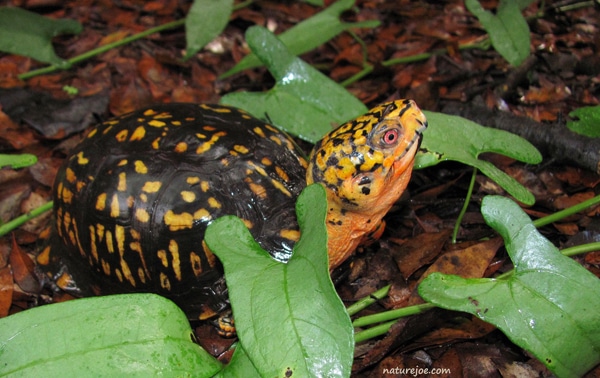Here are a few tips for keeping the Eastern box turtle (Terrapene carolina carolina) alive and well in captivity, including care of the hatchlings. F
Here are a few tips for keeping the Eastern box turtle (Terrapene carolina carolina) alive and well in captivity, including care of the hatchlings. First off this is not an easy species to keep when compared to others, and I would never recommend this one to a “first-timer” at keeping turtles. As beautiful as some individuals of this species may be, the temptation may be strong to collect one during a walk through a field or woodland, and from experience they are best for photography only, and to be left right where they were found.
If collected and placed into captivity, even under the best of conditions only about 1-2 out of five will do really well for you, and the rest will experience problems (puffy eyes, refusing to eat, etc.), and again are best used for a few nice pictures on location, then left right where they were found. Also keeping them year ’round is risky business because of hibernation, and in this article we’ll take a look at these factors of keeping them successfully.
Read More
Herping the Eastern Box Turtle
Eastern Box Turtle Ear Infection
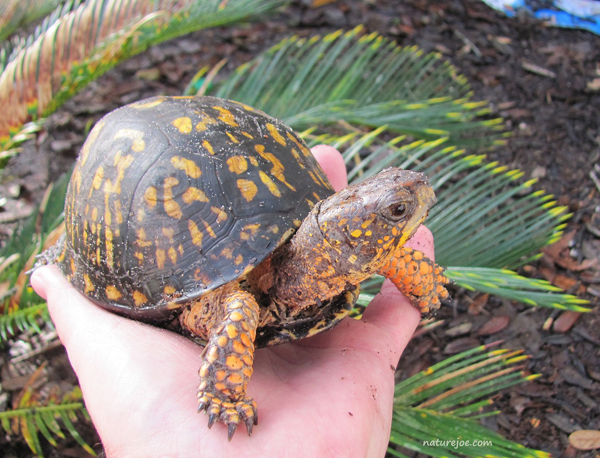
joe myers
This species usually fits comfortably in the palm of your hand, but handling should be limited to feeding, cleaning, and photography.
Sadly these are sometimes seen in pet stores outside their protected range, and if you have the chance to obtain a pet store specimen pick it up and look it over first. Many are very lightweight and malnourished, and if you see a really pretty one it may be the risk of purchase to try and restore it to health. If you do decide to buy one make sure it eats first, as some pet store turtles (probably wild-caught elsewhere and sold to the store, and have never been fed since the day they left the wild) may be too far gone to be recovered and it will be a waste of money to even try. If they allow it to be fed while you’re there and if it eats, it may be well worth your effort to get it. Also before adding it to your shopping cart look at the eyes to see if they are bright and clear, and look for any signs of any fresh injury, etc.
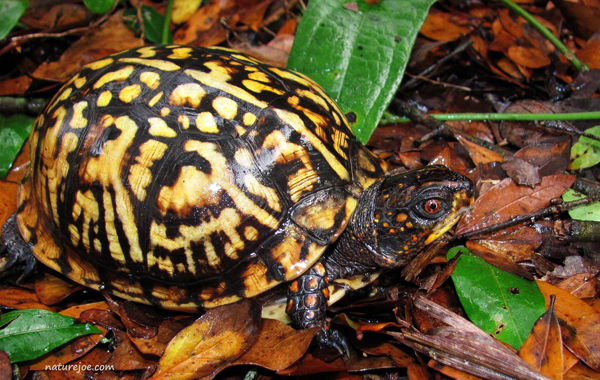
joe myers
If you buy one, make sure it is in good health to avoid problems with it in the future.
Concerning the purchase of a pet store turtle, the first goal is to get some weight back on it. Also never mix it with other turtles because it could harbor an unseen disease that could quickly race through your entire collection! The first thing you’ll want to do is get some weight on it, and the setup at first can be rather simple, such as a large (about 30-gallon) Rubbermaid-type container or 20-gallon aquarium, and over one end of it place a reflector containing a 40 or 60-watt bulb for heat.
I keep the setup as simple as possible. I place an object under one end of it to slant the container. I add water so about about 1/2 of it contains water, and 1/2 is dry land. I try feeding it several times a day. It won’t eat at every feeding but I’m happy and thankful for the times it does. The setup I describe here is temporary only, unless your turtle really starts to thrive in this setup and seems happy there, since it’s known that this species can sometimes fall back into ill health after being moved from one setup to another.
Concerning foods and feeding, one of the “nursery” foods I use to help add some weight and health back to it is a handful of 93% (or higher) lean raw hamburger or ground deer meat (concerning turtles, if you have deer meat ground into “hamburger”, tell the butcher not to add any beef fat or other fillers to it), and to this meat add a pinch of RepCal, or similar reptile calcium powder and mix it well. This feeding also helps to tame your turtle. Once my turtle eats well I’ll take it out and place the turtle on one hand while it takes food from the other. I feed it until it’s full before placing it back into the container. Other important foods are nightcrawlers, small crayfish, and large crickets. Once it feeds normally I slowly switch it to a more vegetarian diet, by introducing bananas (concerning bananas, they like them on the ripe side rather than “green”), and red juicy strawberries, cantaloupe, and apple slices. If your turtle takes a liking to Romaine lettuce, so much the better!
A common practice among summer camps and nature centers is to house a couple locally-caught specimens for the summer and to release them at the end of the season. This is not the best idea since this species doesn’t like handling too well, and if the building is too cool, health problems will surely result, and if kept in a natural “woodsy” setup they will remain buried down out of sight for days at a time. I suggest getting a few nice pictures to mount in the building of this shy species, and collecting a couple aquatic turtles instead for the summer, since these are active and visible, and handling is less likely. Also the laws of the land for keeping these even temporarily may vary from state to state. In some states they are strictly forbidden in captivity.
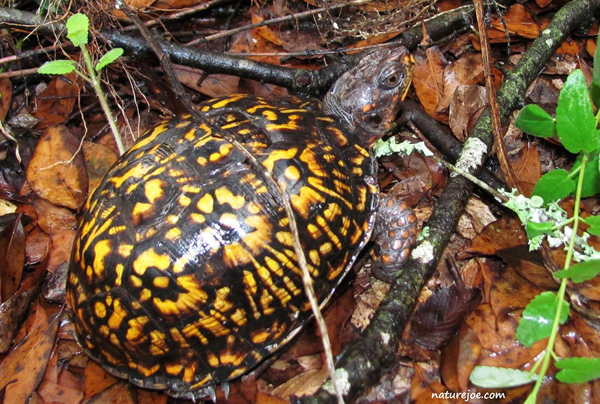
joe myers
These thrive best in large, secure outdoor pens.
Perhaps the best way to keep Terrapene carolina carolina successfully is in a large outdoor turtle pen. The larger the better, with plenty of morning sun and shaded areas available throughout the day as well. A pen constructed in a wind-protected area is best, such as on the South side of a building with plenty of vegetation to offer shade as well, and they can also be hibernated here later in the season. I prefer this over placing the pen in a woods, since a forest setting will be too much shade for them, however if you live in an arid region such as among the prairies or desert, more shade may be needed.
A note concerning arid regions, the ornate box turtle will thrive VERY well in arid regions. You may want to keep these instead if you live in dryer regions, but Easterns will do well if the area is well-protected from the wind and hot sun, and is sprayed down with a hose every other day or so during the long hot dry spells.
Dominant males are real fighters and will attack any other male added, so from experience I have learned to never keep more than one dominant male in among them, and if you have two dominant males it’s best to set up a smaller pen for one separately, and about twice a month a female can be introduced to his enclosure if you plan on breeding them.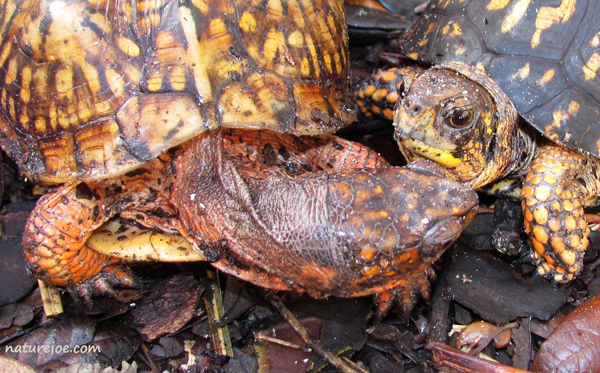
joe myers
While males are prone to fight each other as adults, the females can be kept together comfortably, such as seen here.
When building a pen it is best to bury the bottom a couple inches into the ground, and I do this by digging a narrow trench and dropping the fence into this and filling it back in. Also I bend the top of the fence inward to avoid having them climb out. They are true escape artists and I check the perimeter regularly to see if they’ve been burrowing next to the fence. I try to encourage a “burrowing area” for them, usually an area near the building where they will eventually hibernate, and to do this I dig down a foot or so and add a lot of sphagnum peat to make the soil extra soft in this area, and it’s mixed together with a shovel, and kept a bit uneven and covered slightly with dead leaves, and during any month they have access to a place they can hide in. More about hibernation in a moment, but for their water I keep a very shallow (less than two inches deep) large plastic pan in there for them, and don’t be surprised if they never use it! This species usually drinks water right off the ground when it is raining, but if the Purina Naturals mix is being fed to them, water is VERY important since the dry pellets demand a lot of moisture to digest.
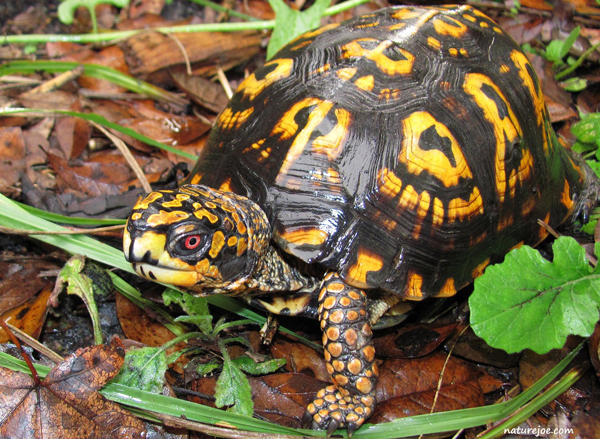
joe myers
Dominant males will fight, and only one is suggested for an enclosure to avoid injury. The males have bright red eyes.
For hibernation I keep a close watch on the temperatures, and usually sometime in late-September I place a few more dead leaves on the area that was dug for them and an old piece of carpet to encourage them to use that spot. They should start burrowing more deeply in October, and by November they should be nearly out of sight. At this point they should never be disturbed. They may emerge on warm days and some may even wander a bit, and on days such as these they will not eat. Around nightfall they should be placed back into their burrowing area if they haven’t already went to it. Once cold weather has arrived and before the ground freezes, at this time I start to add a lot more dead leaves to the burrowing area. From personal experience I found the very best leaves to use are those of white oak (Q. alba) and hickory, since these don’t pack down totally flat, and other leaves I find that are OK are sugar maple (A. saccharum), Sycamore (or any of the Planetrees, Platanus sp.) and any species of apple.
Once I place about a foot-thick pile of leaves over the area I place a piece of carpet over the area to keep the wind from blowing the leaves away. When I used to live in Ohio (a place with zero-degree winters at times) I would set up a temporary fence around the hibernating area to keep the leaves in place, and would drive to a nearby woods and fill several plastic trash bags full of oak and hickory leaves for them. With this setup, I had 100 percent hibernation success for them every year.
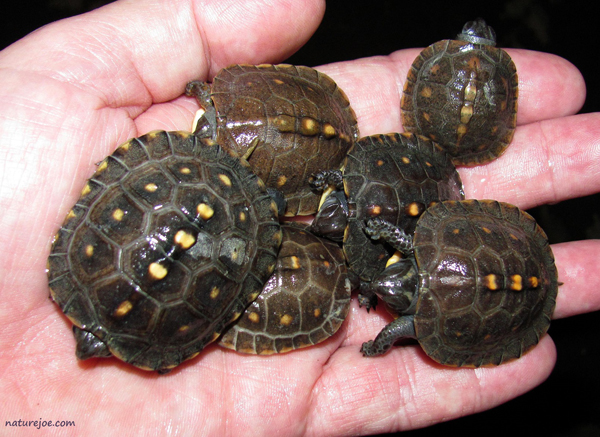
joe myers
Hatchlings of this species often come in different sizes, and often the smaller ones are bullied by larger ones and are best kept with one per container for their own safety.
Concerning the hatchlings, these are difficult to get started, and sadly there are always a few that never really “take off” and for reasons unknown will die. On the average out of a group of ten, you’ll lose about three, some will do poorly all along, and about five or six will do really well – even rivaling the Wood turtle (C. insculpta) in excellence. They will literally come running to you at feeding time and can be hand fed, and are flawless captives! For someone who wants just one pet turtle (that could easily outlive them!) I could hardly think of a better turtle! They go through many color and pattern changes as they grow, and within ten years they will look much like their parents, but will show the true “box turtle” pattern in about half that time. Here’s their one downfall: Each one should be housed separately for the first six months or so, because when very young they will attack each other as “food,” and nubbed tails, skinned heads, gouged eyes, and missing claws will be the result! Even in a good-sized container they will attack each other, often with injuries. When they are small I set them up in four rectangular plastic shoe boxes with one turtle per container, and with one reflector lamp placed over the area. The containers are tilted slightly so the water stays in one end. The water must be very shallow at all times because another bad habit these have (besides biting each other) is flipping themselves over onto their backs. In water deeper than a half inch they may easily drown. With some individuals this is never a problem, while with others they are on their backs about every time I walk into the room, and thankfully they will outgrow this after several months of good growth.
Starting the young ones to feed is the tricky part concerning this species, and once they feed well you should have no problems (except for them biting each other, and flipping over) rest of the way with these, and an easy way I use to “start” them is to wait several weeks after hatching and the yolk sac is gone. At this point I’ll take a tiny piece of meat and place it on a very thin stick or broomstraw and wiggle it at ground level about a half-inch in front of it. This should catch its attention. Once it takes the meat, this process is repeated, and if one refuses food, try placing it in very shallow water (just enough to cover its head) and try again, and some seem to prefer being “water turtles” until they begin feeding well. Also if the meat doesn’t do the trick, try small sections of cut-up earthworms, and the natural movement will often tempt a strike. Once they’re feeding well, about a month later I get mine onto a staple diet of ReptoMin, which are small green floating food sticks that make a good staple diet for them. From there I feed them meat, earthworms, and mealworms mostly, and after a year or so they’ll take such foods as bananas and strawberries, which can be freely added in. Also keeping them reasonably stuffed with a variety of foods will allow them to grow normally, with no shell deformities.
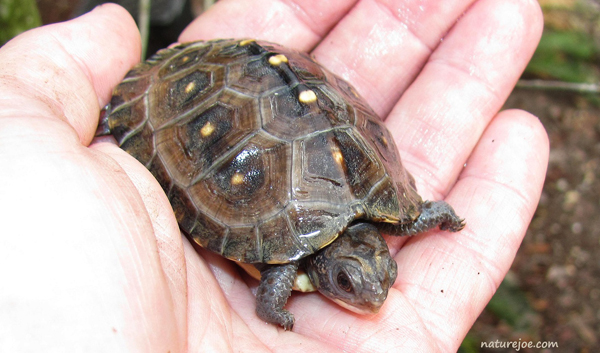
joe myers
The juvenile pattern shown here remains for about the first six months, and after about five years the true pattern starts to show.
One last note concerning your box turtles. Let’s say you have indoor turtles and you go on vacation for a week or so. No problem! Providing your turtle is healthy, simply cut back on its food about a week or so ahead of your vacation, and remove any water and add about a foot of moist dead leaves a day or so before leaving, and your turtle will dig down out of sight until you return. Also no additional light is needed during this time, and your turtle will be one less thing to worry about while you’re relaxing on that cruise.
“Nature” Joe (Myers) is a nature photographer and has many years of experience with the Eastern box turtle and field herping. He has been working with groups of people of all ages in an outdoor educational setting since 1986 and can be followed on Facebook https://www.facebook.com/n.joe.myers where his nature photography and time-lapse videos are displayed there publicly.

